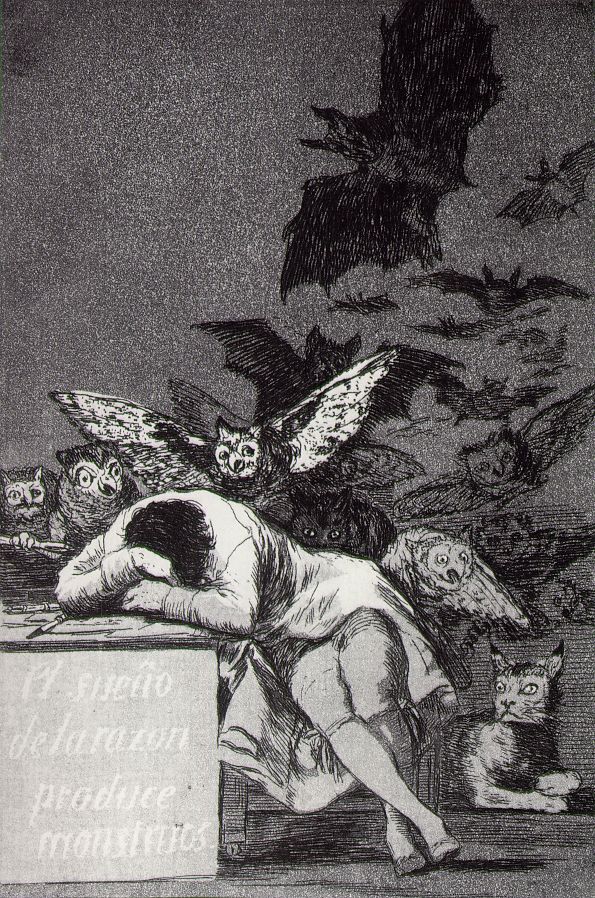Francisco Goya de Lucientes’ “Los Caprichos”

Francisco Goya, "The Sleep of Reason Produces Monsters," plate 43 from his famous etchings, "Los Caprichos"
Francisco Goya’s passion for his homeland was both a great strength and weakness. It was intense enough to carry this scrappy youth from the barren rural outpost of Aragon to a long and illustrious career as the official court painter to the Royal family in Madrid. His powerful depictions of Spanish life were the lifeblood of an oeuvre unrivaled in its scope of style and subject. In certain instances however, it was misunderstood and vilified.
“Los Caprichos,” for one, was an exercise in ineptitude. Here was an item that could have used a PR makeover. At the time of their release in 1799, the Inquisition was waning and the Enlightenment was encroaching.
In the spirit of such revolutionary change, Goya wanted to inspire his fellow Spaniards to take a step back and look at the shortcomings of their character, in the interest of an utopian future. His depictions of society’ failings had a purely reformative intent, and were to be partly taken in jest. That didn’t really end up happening, simply because the public wasn’t in on the joke.
Could you really blame them? Up until then, Goya was best known by the average Madrileño for his spirited and unconventional portraiture. Definitely racy stuff, but still fitting within traditional painterly standards. Then in February of 1799, he puts out an advertisement in the local newspaper, El Diario de Madrid, proclaiming the release of something that isn’t a painting? A series of graphic prints? And to top it off, these aren’t portraits or scenes of Spanish life, but rather the artist’s account, as stated in the ad, of “the innumerable foibles and follies to be found in any civilized society, and from the common prejudices and deceitful practices which custom, ignorance, or self-interest have made usual.”?
Yeah thanks, but no thanks. No wonder only 27 out of the original 300 printings sold.
As is the case with many isolated geniuses, Goya’s progressive ideals were propelled by a heightened sense of himself. He had to delve into the darkest, most cynical recesses of his mad genius to summon such fantastical imagery, along with the summoning the courage to publish what most of us would never have the guts to express.
The problem with this of course, is that such radical undertakings don’t often inspire or engage their intended audience, they alienate it. People don’t want to deal with uncomfortable truths.
Leon Golub, a Goya devotee and renowned painter known for his controversial political subjects, once quipped in Robert Hughes’ BBC documentary on the artist:
“Nobody wants (except for a few maniacs..) to look at ugly things, ok? We recognize that our lives are relatively short. We want to have pleasure, ok? We want to have a few orgasms, here and there, you see? We want to enjoy some landscapes, ok?…Why the hell do I have to look at this junk for?” (see above)
Golub ascertains that it’s only a good fifty or sixty years until the coast becomes clear. Only then, does the public feel secure enough to lionize the rebel artist and such inspired vision.
In one of the classic images from the Caprichos, “The Sleep of Reason Produces Monsters,” Goya champions rational thought over emotion,and the inevitable struggle that we face to maintain such order. In the interest of personal finance, perhaps Goya could have taken his own advice. Common sense would have refrained him from attempting to sell the graphic series in the first place.
While Goya’s contemporaries may have turned a deaf ear, his message has spoken volumes in the ages ever since, and rings especially true today. One need only turn to the frontpage headlines of your own newspaper for a sample of impassioned conflicts where reason is not only asleep, but in a coma. Within the polarized temperament of these “Us Versus Them,” “ You are with Us or Against Us,” battles, “The Sleep of Reason” reminds us to keep a level head and strive for a more nuanced view of ourselves and our adversaries. The passion that spurns the noblest cause, after all, can still coarsen the heart.
Source: http://omnparts.com